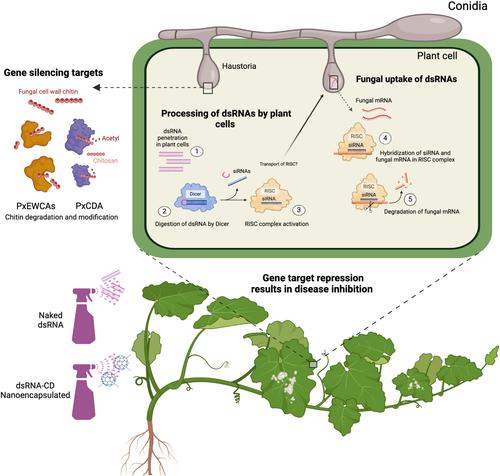当前位置:
X-MOL 学术
›
Pest Manag. Sci.
›
论文详情
Our official English website, www.x-mol.net, welcomes your
feedback! (Note: you will need to create a separate account there.)
Fungal effector genes involved in the suppression of chitin signaling as novel targets for the control of powdery mildew disease via a nontransgenic RNA interference approach
Pest Management Science ( IF 3.8 ) Pub Date : 2025-01-11 , DOI: 10.1002/ps.8660
Nisrine Bakhat, Alejandro Jiménez‐Sánchez, Laura Ruiz‐Jiménez, Isabel Padilla‐Roji, Leonardo Velasco, Alejandro Pérez‐García, Dolores Fernández‐Ortuño
Pest Management Science ( IF 3.8 ) Pub Date : 2025-01-11 , DOI: 10.1002/ps.8660
Nisrine Bakhat, Alejandro Jiménez‐Sánchez, Laura Ruiz‐Jiménez, Isabel Padilla‐Roji, Leonardo Velasco, Alejandro Pérez‐García, Dolores Fernández‐Ortuño

|
BACKGROUNDChitin is a crucial component of fungal cell walls and an effective elicitor of plant immunity; however, phytopathogenic fungi have developed virulence mechanisms to counteract the activation of this plant defensive response. In this study, the molecular mechanism of chitin‐induced suppression through effectors involved in chitin deacetylases (CDAs) and their degradation (EWCAs) was investigated with the idea of developing novel dsRNA‐biofungicides to control the cucurbit powdery mildew caused by Podosphaera xanthii .RESULTSThe molecular mechanisms associated with the silencing effect of the PxCDA and PxEWCAs genes were first studied through dsRNA cotyledon infiltration assays, which revealed a ≈80% reduction in fungal biomass and a 50% decrease in gene expression. To assess the impact on powdery mildew disease control, in vitro and in planta assays were carried out in growth chamber and glasshouse experiments, with ≈50% reduction in disease symptoms after 8 days postinoculation (dpi) in leaf discs and 12 dpi in plants’ leaves, respectively. This control was extended for 21 days when the dsRNAs were protected on the carbon dot nanocarriers. Additionally, the uptake of the dsRNAs by fungal spores was observed 12 h postapplication via confocal microscopy, and efficient processing of dsRNAs into siRNAs by the melon RNAi machinery was observed 24 h postspraying through sRNA‐seq.CONCLUSIONSThis study highlights notable advancements in environmentally friendly disease management, and features the technological potential of RNA‐based fungicides together with nanotechnology for cucurbit powdery mildew control. © 2025 Society of Chemical Industry.
中文翻译:

参与抑制几丁质信号传导的真菌效应基因,作为通过非转基因 RNA 干扰方法控制白粉病的新靶标
背景奇荟素是真菌细胞壁的重要组成部分,也是植物免疫的有效诱发剂;然而,植物病原真菌已经发展出毒力机制来抵消这种植物防御反应的激活。在这项研究中,研究了通过参与几丁质脱乙酰酶 (CDA) 及其降解 (EWCA) 的效应子诱导几丁质诱导抑制的分子机制,并提出了开发新型 dsRNA 生物杀菌剂来控制由 Podosphaera xanthii 引起的葫芦白粉病的想法。结果首先通过 dsRNA 子叶浸润试验研究了与 PxCDA 和 PxEWCAs 基因沉默作用相关的分子机制,结果显示真菌生物量降低 ≈80%,基因表达降低 50%。为了评估对白粉病病害控制的影响,在生长室和温室实验中进行了体外和植物试验,叶盘接种后 8 天 (dpi) 和植物叶子接种后 12 dpi 后疾病症状分别减轻了 ≈50%。当 dsRNA 在碳点纳米载体上受到保护时,这种控制延长了 21 天。此外,在施用后 12 小时通过共聚焦显微镜观察到真菌孢子对 dsRNA 的摄取,并在喷涂后 24 小时通过 sRNA-seq 观察到瓜 RNAi 机制将 dsRNA 高效加工成 siRNA。结论该研究强调了环境友好型病害管理方面的显着进展,并展示了基于 RNA 的杀菌剂与纳米技术在葫芦白粉病控制方面的技术潜力。© 2025 化工学会.
更新日期:2025-01-11
中文翻译:

参与抑制几丁质信号传导的真菌效应基因,作为通过非转基因 RNA 干扰方法控制白粉病的新靶标
背景奇荟素是真菌细胞壁的重要组成部分,也是植物免疫的有效诱发剂;然而,植物病原真菌已经发展出毒力机制来抵消这种植物防御反应的激活。在这项研究中,研究了通过参与几丁质脱乙酰酶 (CDA) 及其降解 (EWCA) 的效应子诱导几丁质诱导抑制的分子机制,并提出了开发新型 dsRNA 生物杀菌剂来控制由 Podosphaera xanthii 引起的葫芦白粉病的想法。结果首先通过 dsRNA 子叶浸润试验研究了与 PxCDA 和 PxEWCAs 基因沉默作用相关的分子机制,结果显示真菌生物量降低 ≈80%,基因表达降低 50%。为了评估对白粉病病害控制的影响,在生长室和温室实验中进行了体外和植物试验,叶盘接种后 8 天 (dpi) 和植物叶子接种后 12 dpi 后疾病症状分别减轻了 ≈50%。当 dsRNA 在碳点纳米载体上受到保护时,这种控制延长了 21 天。此外,在施用后 12 小时通过共聚焦显微镜观察到真菌孢子对 dsRNA 的摄取,并在喷涂后 24 小时通过 sRNA-seq 观察到瓜 RNAi 机制将 dsRNA 高效加工成 siRNA。结论该研究强调了环境友好型病害管理方面的显着进展,并展示了基于 RNA 的杀菌剂与纳米技术在葫芦白粉病控制方面的技术潜力。© 2025 化工学会.































 京公网安备 11010802027423号
京公网安备 11010802027423号